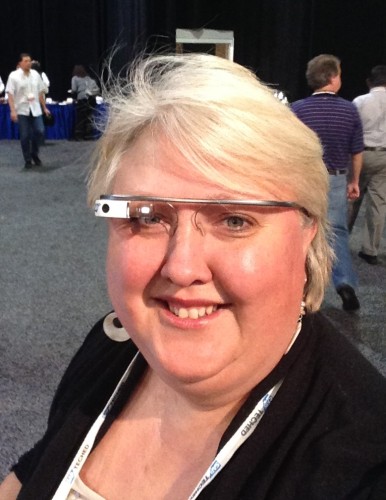Today at the SAP TechEd conference I got a change to try out Google Glasses in conjunction with an SAP-powered warehouse application.
Up to now, I haven’t been a big fan of Google Glass. If you need to know something, how hard is it to pull out your phone and look it up?
Wearing Google Glasses seemed pretentious and nerdy.

Okay, it still seems pretentious and nerdy. (I’m allowed to use the word “nerd” because some of my home computers run Linux.)
But I can now see that they can make sense in particular contexts.
The demo I got to try was an application that allows warehouse workers to track and manage inventory. You can scan a barcode on a package and the app tells you what to do with it. You can do the same thing with a handheld scanner, of course — but I can see that it would be super convenient to have both hands free.
In the demo video below, the glasses are actually made by a different company, Vuzik. But those glasses weren’t available yet, so SAP used Google Glass for the conference demo.

The Vuzik version is better suited for a warehouse, said Nick Brown, SAP’s senior vice president for mobile strategy. with a connected battery pack for all-day use.
“And Vuzik gives you a richer view, higher resolution, and the ability overlay augmented reality over the object you’re looking at,” he told me. “A little more industry-level strength, more comfort, and better form factor.”
The augmented reality overlays, for example, would be useful for field maintenance techs, who could look at an object and immediately pull up a schematic of the interior  to help them work on it.
Using the glasses reminded me of old-school menu-based applications. You get a screen with a handful of choices. You scroll through them by stroking the side of your glasses up, down, forwards, or back, and tapping to select. It took me a few tries to get a hang of this, however — it’s not as intuitive as using a touch screen.
The menu-based approach means that it’s easy to program, however, and easy to use — especially if you’re using just one application all day, every day, as you would be in a warehouse.
I particularly liked the way the app would recognize if I was looking directly at a bar code and scan it in, though it took me a bit of effort to get the bar code into the correct position — and that was with bar codes that were five or ten times larger than normal.
“You’re bringing up what we still see as challenges in bringing wearables to the mass market,” said Brown.”We need improvements. We need great cameras. We need good voice recognition. What if I wear glasses? The technology is there to solve all these issues, but we need to work it through.”
The Vuzik glasses will hit the market in the first part of 2014, and several Asian companies are already planning deployments, he said.
“I think you’re going to see a ton of them,” he said.
Until then, companies need to do some preliminary work to get their facilities ready, such as highly accurate positioning abilities in their warehouses, or 3D renderings of the assets.
Another application he told me about, which I didn’t see demonstrated, was being able to identify an item just by looking at it, which is where the 3D rendering comes in.
Say, you have a part — a bolt, or an elbow joint — that you keep in a bin. No label, no bar code. The employee will look at the item, or hold it up, and the glasses will take two pictures of the item from the two built-in cameras, calculate its size, and send them to a database for a comparison. The database holds not only the original 3D rendering of the item, but pictures of how it would look from different directions.
“We put the data about the objects into HANA, our in-memory database in the cloud,” Brown said. “It is incredibly fast — the response time is subsecond.”
The glasses themselves, and the communication back, is where most of the latency comes from, he added, but looking up an item takes five seconds at most.
A tablet would still be more convenient for applications where you didn’t need to have constant, real-time, hands-free access to data. Even if your hands get dirty, you can put a tablet inside a Ziploc bag.
The goal, Brown said, is to design the back-end systems so that they can work with a variety of possible devices, including devices that might not have been invented yet.
- OSgrid back online after extended maintenance - April 16, 2025
- Analysts predict drop in headset sales this year - March 25, 2025
- OSgrid enters immediate long-term maintenance - March 5, 2025
